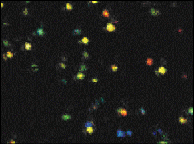
DNA Forms Molecular Photonic Wire
Daniel S. Burgess
Scientists from the University of Bielefeld in Germany and the University of Twente in Enschede, the Netherlands, have demonstrated that standard fluorophores and strands of DNA may be combined to form molecular photonic wires that operate by Förster resonance energy transfer. The work has potential implications for the development of nanoscale photonic devices for use in modeling photosynthetic biological systems and in materials chemistry.

Fluorophores attached to DNA act as molecular photonic wires based on Förster resonance energy transfer. Different colors exhibit different energy transfer efficiencies across the 13.6-nm-long wire. Courtesy of Markus Sauer.
In a molecular photonic wire, light absorbed at one end converts into excited-state energy and passes down the chain from one component to another until it reaches the end, where it re-emits as photons or converts into an electric charge, explained Markus Sauer of the University of Bielefeld. A recent proposal to accomplish this involves the use of fluorophores with high quantum yields, arranged such that the energy is transferred by weak dipole-dipole induced interactions that prevent quenching.
In their work, the researchers investigated the use of DNA strands with 20 or 60 bases for the scaffold that holds the fluorophores of the 13.6-nm-long wire in position. They used five different commercial fluorophores.
To test the efficiency of the wires, they excited the first fluorophores in the series through a confocal microscope with 488-nm light from an argon-ion laser. Four wavelength-specific avalanche photodiodes collected the response from the ends of the wires through the microscope and a series of beamsplitters. The researchers found that overall energy transfer efficiencies were between 15 and 30 percent but that approximately 10 percent of the wires had an efficiency of 90 percent.
Sauer said that future molecular photonic wires may involve zeolites as support structures, and their operation may be based on an alternate energy-transfer mechanism. The group currently is investigating the use of selective quenching of a fluorophore in the wire by a second laser to enable controlled switching.
Published: September 2004